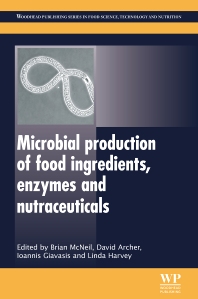Books in Agricultural and biological sciences
Books in Agricultural and biological sciences
The Agricultural and Biological Sciences collection advances science-based knowledge for the improvement of animal and plant life and for secure food systems that produce nutritious, novel, sustainable foods with minimal environmental impact. Food Science titles include not only those products from agriculture but all other aspects from food production to nutrition, health and safety, chemistry to security, policy, law and regulation. Biological Sciences address animal behaviour and biodiversity, organismal and evolutionary biology, entomology, marine biology and aquaculture, plant science and forestry.
- 1st Edition
- March 26, 2013
- Jan A Delcour + 1 more
- English
- Hardback9 7 8 0 8 5 7 0 9 0 3 8 6
- eBook9 7 8 0 8 5 7 0 9 5 7 8 7

Fibre-Rich and Wholegrain Foods
- 4th Edition
- March 25, 2013
- Laurie J. Vitt + 1 more
- English
- Hardback9 7 8 0 1 2 3 8 6 9 1 9 7
- eBook9 7 8 0 1 2 3 8 6 9 2 0 3

Herpetology
- 1st Edition
- Volume 69
- March 21, 2013
- English
- Hardback9 7 8 0 1 2 4 1 0 5 4 0 9
- eBook9 7 8 0 1 2 4 1 1 5 0 0 2

Advances in Food and Nutrition Research
- 1st Edition
- March 21, 2013
- Brian McNeil + 3 more
- English
- Hardback9 7 8 0 8 5 7 0 9 3 4 3 1
- Paperback9 7 8 0 0 8 1 0 1 5 5 9 9
- eBook9 7 8 0 8 5 7 0 9 3 5 4 7

Microbial Production of Food Ingredients, Enzymes and Nutraceuticals
- 1st Edition
- Volume 12
- March 16, 2013
- English
- Paperback9 7 8 0 0 8 0 9 7 5 5 5 9
- Hardback9 7 8 0 0 8 0 9 8 2 2 2 9
- eBook9 7 8 0 0 8 0 9 8 2 2 5 0

Forest Monitoring
- 3rd Edition
- March 8, 2013
- John G. Fleagle
- English
- Hardback9 7 8 0 1 2 3 7 8 6 3 2 6
- eBook9 7 8 0 1 2 3 7 8 6 3 3 3

Primate Adaptation and Evolution
- 4th Edition
- March 6, 2013
- J. Glenn Morris Jr.
- English
- Paperback9 7 8 0 3 2 3 2 8 2 2 0 8
- Hardback9 7 8 0 1 2 4 1 6 0 4 1 5
- eBook9 7 8 0 1 2 3 9 1 4 7 6 7

Foodborne Infections and Intoxications
- 1st Edition
- March 4, 2013
- Jacqueline B. Marcus
- English
- Paperback9 7 8 0 1 2 3 9 1 8 8 2 6
- eBook9 7 8 0 1 2 3 9 1 8 8 3 3

Culinary Nutrition
- 1st Edition
- February 27, 2013
- Steve Webb
- English
- Hardback9 7 8 0 1 2 4 0 7 7 9 0 4
- Paperback9 7 8 0 3 2 3 2 8 2 6 1 1
- eBook9 7 8 0 1 2 4 0 7 8 4 0 6

Corridors to Extinction and the Australian Megafauna
- 1st Edition
- February 26, 2013
- Neil Farmer
- English
- Hardback9 7 8 0 8 5 7 0 9 5 0 3 9
- eBook9 7 8 0 8 5 7 0 9 8 9 7 9

Trends in Packaging of Food, Beverages and Other Fast-Moving Consumer Goods (FMCG)